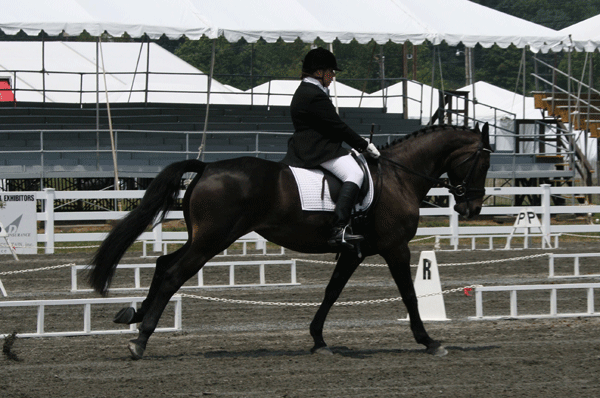I talked last week about the movement in First Level Test 3 where the transition from lengthened to working canter is supposed to happen well before the corner but rarely does. The test writers are really trying to help the riders out here by preparing them for movements at higher levels, especially a canter extension across the diagonal that finishes with collected canter and then a flying change. Note, I said collected canter before the flying change. What judges see all too often is the rider turning onto the long side at end of the diagonal without collecting, followed by a flying change going directly into the corner.

This isn’t the way the rule is written for such movements, which specifies that the transition to collection and the change must both happen while still on the diagonal line. Here it is in the USEF Rule Book:
“In a movement which must be carried out at a certain point of the arena it should be done at the moment when the competitor’s body is above this point, except in transitions where the horse approaches the letter from a line diagonal or perpendicular to the point where the letter is positioned. In this case, the transition must be done when the horse’s nose reaches the track at the letter so that the horse is straight in the transition. This includes the execution of flying changes.” (Rule DR121.7.b)
There are at least a couple reasons for this rule: first, that the rider directs the transition and change, not the rail itself; second, to promote straightness in both the transition and change. The transition on the long side at First 3, from lengthened to working canter at R and P, is a good start for a rider who will eventually do a similar transition on the diagonal, and there it will be a much harder effort from extension into collection, followed by a flying change.
If the judge fails to see collection in this movement on the diagonal, there will be a comment such as “collection unclear” and a score than will likely be below a 7 no matter how good the change. If there’s no collection at all and the horse turns onto the long side before the change, the score could be even lower. Sometimes we’ll see a transition to collection but it occurs at the quarter line — the rider might start to prepare there with perhaps a half halt or brief counter bend, but the horse should be seen to “sit” closer to the long side. We might also see a good start to the extension but then the rider lets it ooze away somewhere near X so that there really isn’t a transition at all.
I have a dramatic vision in my head of a freestyle ride by Isabell Werth on Gigolo back in the ’90s, where she would blast across an oblique diagonal from H to near A, do a transition to collection within a couple steps, followed by a 1 1/2-turn pirouette, return on the same line with two-tempi changes, and then repeat on the other side of the ring but with one-tempis. I’m not sure that exact pattern had been attempted before, but it was so dramatic that it made a huge impact. I now see versions of the same movement in a lot in FEI freestyles, but where riders often don’t pull it off as well is with the quality of the transition from the extension directly into the pirouette, so that the balance just isn’t as good. That freestyle is easy to find on YouTube if you want to see for yourself (the music starts with “Just a Gigolo”).











